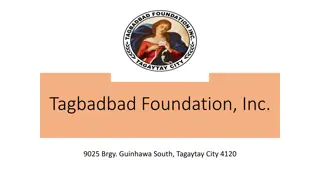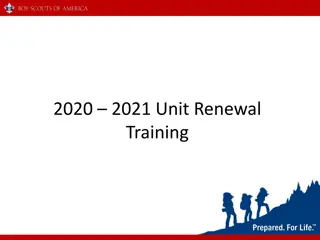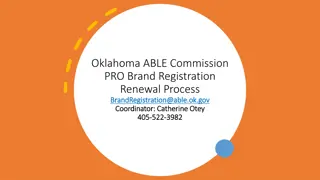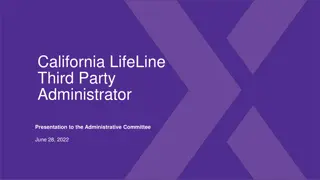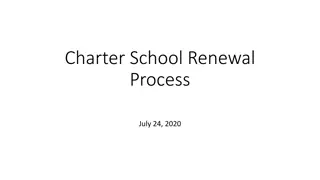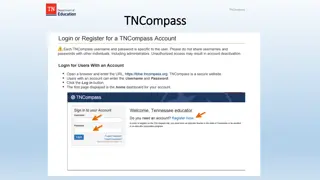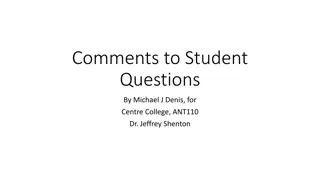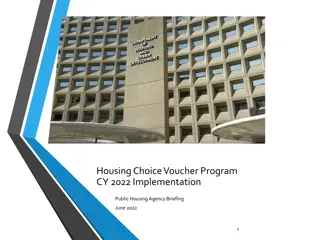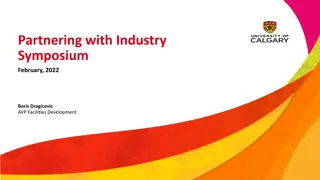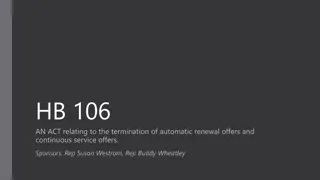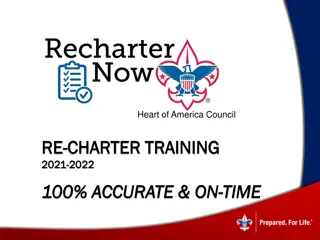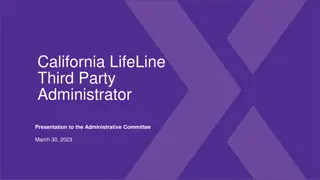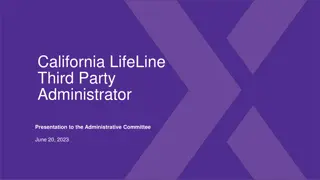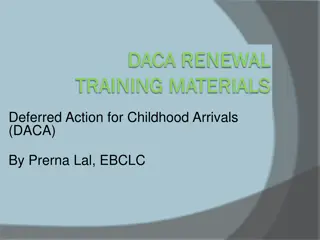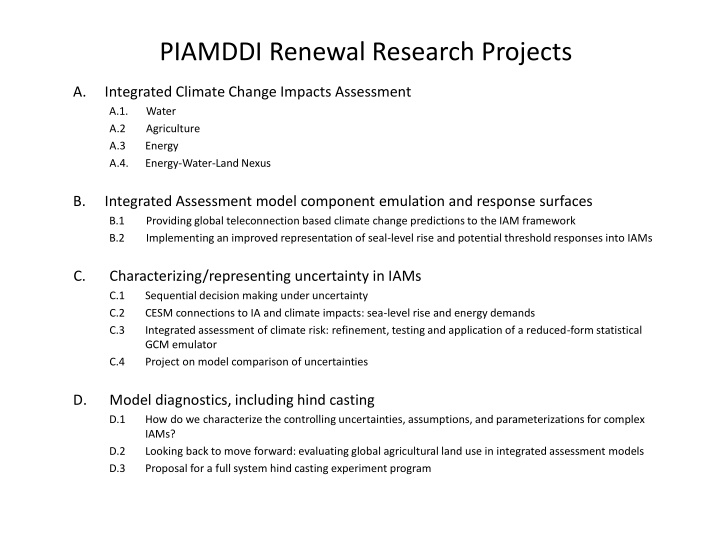
Climate Change Impacts Assessment and Uncertainty Characterization in Integrated Assessment Models
Explore a comprehensive research project focusing on climate change impacts assessment across water, agriculture, and energy sectors. The project also delves into uncertainty characterization in integrated assessment models, including global teleconnection predictions, sea-level rise representation, and model diagnostics. Discover the intricate connections between climate change, energy demand, water resources, and agriculture in response to changing environmental conditions.
Download Presentation

Please find below an Image/Link to download the presentation.
The content on the website is provided AS IS for your information and personal use only. It may not be sold, licensed, or shared on other websites without obtaining consent from the author. If you encounter any issues during the download, it is possible that the publisher has removed the file from their server.
You are allowed to download the files provided on this website for personal or commercial use, subject to the condition that they are used lawfully. All files are the property of their respective owners.
The content on the website is provided AS IS for your information and personal use only. It may not be sold, licensed, or shared on other websites without obtaining consent from the author.
E N D
Presentation Transcript
PIAMDDI Renewal Research Projects A. Integrated Climate Change Impacts Assessment A.1. Water A.2 Agriculture A.3 Energy A.4. Energy-Water-Land Nexus B. Integrated Assessment model component emulation and response surfaces B.1 Providing global teleconnection based climate change predictions to the IAM framework B.2 Implementing an improved representation of seal-level rise and potential threshold responses into IAMs C. Characterizing/representing uncertainty in IAMs C.1 Sequential decision making under uncertainty C.2 CESM connections to IA and climate impacts: sea-level rise and energy demands C.3 Integrated assessment of climate risk: refinement, testing and application of a reduced-form statistical GCM emulator C.4 Project on model comparison of uncertainties D. Model diagnostics, including hind casting D.1 How do we characterize the controlling uncertainties, assumptions, and parameterizations for complex IAMs? D.2 Looking back to move forward: evaluating global agricultural land use in integrated assessment models D.3 Proposal for a full system hind casting experiment program
A. Integrated Climate Change Impacts Assessment A.1 Water A.1.1 Connecting IAMs to water balance models Frolking, Grogan, Lammers, Fisher-Vanden, Sue Wing, Forest, Reed, Shortle How can we link detailed water process model information with IAMs? A.1.2. Climate change adaptation and water resource management Olmstead, Fisher-Vanden, Frolking, Grogan, Lammers, Reed, Shortle, Sue Wing Adaptation measures cannot easily be incorporated into IAMs without an understanding of the institutions (most of them non-market) that determine water allocation, pricing, and infrastructure investments And how these institutions may evolve in response to changing conditions due to climate.
A. Integrated Climate Change Impacts Assessment (continued) A.2 Agriculture A.2.1 Comparison of process models and empirical reduced-form models for incorporation into IAMs Schlenker, Frolking, Grogan, Lammers, Hertel, Fisher-Vanden, Sue Wing How consistent are these alternative approaches to assessing the impacts of climate change on agriculture? What are the trade-offs between these alternative approaches? A.2.2. Improving the empirical basis of agricultural impacts and adaptation in IAMs Schlenker, Diffenbaugh, Hertel, Sue Wing, Fisher-Vanden Update previous empirical work to include more recent climate data Generate new empirical estimates of farmer adaptation, both anticipated and unanticipated Extend to rest of world and build into global IAM. A.2.3. Endogenizing risk-mitigating innovation: the case of agriculture Popp, Schlenker, Diffenbaugh, Hertel, Sue Wing, Fisher-Vanden Previous work explored link between natural disasters and technological change. Incorporate endogenous technological change for adaptation into IAM.
A. Integrated Climate Change Impacts Assessment (continued) A.3 Energy A.3.1 Climate change impacts on energy demand Sue Wing, PNNL/JGCRI, Mansur Incorporate new energy data Estimate cross-country energy demand responses to weather shocks Incorporate into IAMs (e.g., GCAM, Phoenix) A.3.2. Extensive versus intensive energy demand in response to climate change Mansur, Sue Wing, Popp Use household-level energy consumption data to identify how consumers respond to weather shocks e.g., more use of existing A/Cs? Or greater adoption of A/C? A.3.3. Climate change impacts on energy supply Sue Wing, UNH, JGCRI Construct demand functions for cooling water withdrawals that can be incorporated into IAMs Combine these demand functions with hydropower supply functions in IAM to simulate effects of climate on hydroelectricity capacity A.3.4. Advanced energy technology assessment Benson, Weyant Decompose technology choice differences between models into structural and parameter value differences Compare the assumptions made with historical experience and expert elicitations
A. Integrated Climate Change Impacts Assessment (continued) A.4 Energy-Water-Land Nexus A.4.1 The interplay of mitigation, impacts, and adaptation through the bioenergy-land-water nexus Hertel, Diffenbaugh, Schlenker Will bring together two stands of previous research and expand to global scale: 1. How climate mitigation policy (in the form of bioenergy expansion) interacts with physical water scarcity to determine land use change and terrestrial carbon fluxes 2. Interaction between climate change and biofuels mandates, and implications for commodity markets
B. Integrated assessment model component emulation and response surfaces B.1 Providing Global Teleconnection based climate change predictions to the IAM framework Forest, Li, Collins, Sue Wing, Fisher-Vanden, Reed Build statistical spatial-field emulators of key climate variables based on GTOs for use in IAMs Estimate the GTO for the atmospheric model component of the iESM B.2 Implementing an improved representation of sea-level rise and potential threshold response into IAMs Keller, Forest, Sriver, Nicholas, JGCRI/PNNL Implement a spatially-resolved module for sea-level rise into an IAM (e.g., GCAM, FUND, DICE) and into HECTOR. Leverage results from ensemble analyses using CESM to examine the relative of contribution of natural variability vs. anthropogenic forcing to sea-level rise.
C. Characterizing/representing uncertainty in IAMs C.1 Sequential decision making under uncertainty Webster, JGCRI, MIT Joint Program, Fisher-Vanden, Sue Wing Incorporate sequential decision making under uncertainty in IAMs by incorporating Approximate Dynamic Programming (ADP) into models such as GCAM and EPPA. CESM connections to integrated assessment and climate impacts: sea- level rise and energy demands Sriver, Keller, Forest, Nicholas, Sue Wing Utilize the ongoing CESM ensemble to analyze the effect of model uncertainties on spatial variations in sea-level changes and trends. Integrated assessment of climate risk: refinement, testing and application of a reduced-form statistical GCM emulator Sue Wing, Keller, Nicholas, JGCRI Update existing emulator to incorporate recently-generated CMIP5 GCM output Utilize emulator to conduct Monte Carlo realizations of future climates to obtain gridded temp and precip to be used to manipulate crop yields and energy demand in an IAM Project on model comparison of uncertainties Nordhaus, Gillingham Multi-model exercise to understand the key uncertainties affecting the projections of major variables and projections of IAMs. C.2 C.3 C.4
D. Model diagnostics, including hind casting D.1 How do we characterize the controlling uncertainties, assumptions, and parameterizations for complex IAMs? Reed, JGCRI, Fisher- Vanden, Keller Will collaborate with JGCRI to generalize our model diagnostics framework to GCAM. Will provide a mechanism for understanding key mitigation and adaptation uncertainties using rich spatial and temporal visualization of model controls. Looking back to move forward: Evaluating global agricultural land use in integrated assessment models Hertel, Diffenbaugh, Weyant Will assist land-based IAMs in evaluating and improving model performance by looking back at historical experience. A full system hind casting experiment program Santer, Weyant, Fisher-Vanden, Taylor, Smith, Clarke Expand existing hind casting efforts to include more tests of the US-based models and coordinate with the European efforts in this area. Already a plan in place to expand the initial GCAM experiments over longer time horizons and more detailed inputs and outputs Discussion underway with the MIT/EPPA and the EPRI/MERGE modeling groups to design similar hind casting protocols. D.2 D.3
The End THANK YOU



